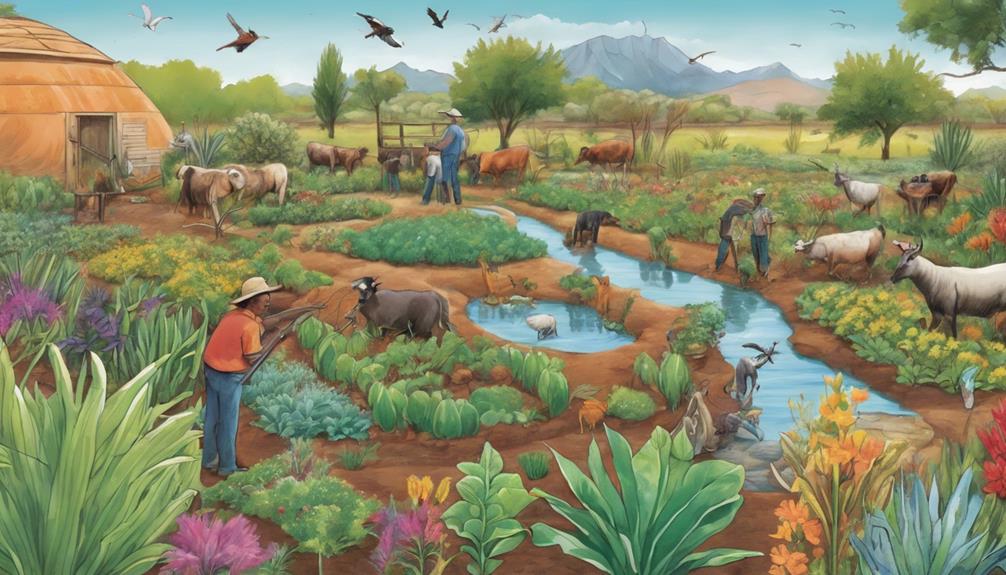Nurturing Biodiversity Through Natural Agricultural Practices
Imagine walking through a flourishing organic farm where rows of vibrant sunflowers sway gently in the breeze, and bees hum busily from one blossom to another. This picturesque scene is not just visually appealing but also crucial for nurturing biodiversity.
By employing natural agricultural practices, farmers can create a harmonious environment where various plant and animal species thrive together. The interconnected web of life that emerges from such practices holds the key to sustainability and resilience in the face of environmental challenges.
The Basics of Organic Farming
To cultivate a sustainable agricultural system, understanding the fundamental principles of organic farming is essential. Organic farming revolves around maintaining soil fertility and effectively managing pests while avoiding synthetic chemicals. Soil fertility is a cornerstone of organic agriculture. By prioritizing the health of the soil through techniques like crop rotation, composting, and cover cropping, organic farmers ensure that the land remains productive for years to come. These practices not only enrich the soil with essential nutrients but also promote biodiversity underground, fostering a healthy ecosystem where crops can thrive naturally.
Pest management is another critical aspect of organic farming. Instead of relying on chemical pesticides that can harm beneficial insects and contaminate the environment, organic farmers employ a variety of methods to control pests naturally. This can include introducing beneficial insects, using traps, and planting companion crops that deter pests. By working with nature rather than against it, organic farmers can effectively manage pests while maintaining a balanced and diverse ecosystem.
Importance of Soil Health
Ensuring the health of your soil is paramount for sustainable agriculture. By implementing soil regeneration techniques and carbon sequestration methods, you can enhance the fertility and resilience of your land. Sustainable agriculture practices, such as crop rotation strategies, play a crucial role in maintaining soil health by preventing nutrient depletion and reducing the risk of pests and diseases.
Soil regeneration techniques like cover cropping and composting help replenish essential nutrients, improve soil structure, and promote microbial activity, fostering a healthy ecosystem underground. These practices not only benefit the soil but also contribute to increased crop productivity and overall farm sustainability. Carbon sequestration methods, such as reduced tillage and agroforestry, aid in trapping carbon dioxide from the atmosphere and storing it in the soil, mitigating climate change effects.
Incorporating sustainable agriculture practices into your farming routines can lead to long-term benefits for both the environment and your crop yields. Crop rotation strategies, for example, help break pest cycles, prevent soil erosion, and maintain soil fertility by diversifying the types of plants grown in a particular area over time. By focusing on soil health, you aren't only nurturing your land but also fostering biodiversity and promoting a healthier ecosystem for future generations.
Enhancing Pollinator Habitats
Enhance pollinator habitats by planting diverse native flowers and creating nesting sites for bees and butterflies. By incorporating native plantings into your sustainable landscaping practices, you can significantly contribute to habitat restoration and ecological balance. Native flowers are well-suited to the local environment, providing food and shelter for pollinators crucial to crop production and ecosystem health.
When selecting native flowers, opt for a variety of species that bloom at different times throughout the year. This ensures a continuous nectar and pollen source for bees and butterflies. Examples of native flowers that attract pollinators include bee balm, coneflowers, and milkweed. Additionally, consider planting flowers in clusters to create focal points that are more attractive to pollinators.
To further enhance pollinator habitats, provide nesting sites for bees and butterflies. For bees, you can create nesting sites by leaving some areas of bare ground, or by installing bee hotels made from natural materials like bamboo or wood. Butterflies, on the other hand, often seek sheltered spots to lay their eggs, so consider incorporating host plants like dill or fennel that caterpillars feed on.
Diversification of Crop Species
Consider diversifying your crop species to promote resilience and sustainability in your agricultural practices. Crop diversification involves growing a variety of crops on the same land, which can help improve soil health, reduce pest and disease pressure, and enhance overall ecosystem balance. One way to achieve this is through crop rotation, where different crops are planted sequentially in the same field. Crop rotation can break pest cycles, improve soil fertility, and reduce the risk of nutrient depletion.
In addition to crop rotation, companion planting is another effective method for diversifying crop species. Companion planting involves growing different plants together to maximize the use of space, nutrients, and sunlight. Certain plant combinations can also help repel pests, attract beneficial insects, and improve pollination. For example, planting marigolds alongside tomatoes can deter nematodes, while planting beans near corn can provide natural nitrogen fixation.
Impact on Wildlife Conservation
By integrating biodiversity-promoting practices in agriculture, you can positively influence wildlife conservation efforts. One significant impact of these practices is the enhancement of wildlife habitats through habitat restoration initiatives. By creating diverse and natural landscapes within agricultural areas, you provide essential ecosystems for a variety of wildlife species to thrive. This is crucial for supporting biodiversity and preserving the natural balance within ecosystems.
Wildlife monitoring plays a vital role in assessing the effectiveness of these conservation efforts. By actively monitoring the wildlife populations within and around agricultural lands, you can gather valuable data on species diversity, population trends, and habitat usage. This information is essential for making informed decisions and adjustments to ensure the conservation strategies are successful in supporting wildlife.
Habitat restoration activities such as planting native vegetation, creating wildlife corridors, and preserving water sources are key components of promoting biodiversity and wildlife conservation in agricultural settings. These actions not only benefit wildlife but also contribute to the overall health and resilience of ecosystems. By actively engaging in habitat restoration projects, you're actively participating in the preservation of wildlife and the enhancement of biodiversity in agricultural landscapes.
Reduction of Chemical Inputs
To promote sustainable agriculture practices, minimizing chemical inputs is essential for maintaining ecosystem health and biodiversity in agricultural landscapes. By reducing the reliance on synthetic pesticides and fertilizers, you can protect beneficial insects, soil microorganisms, and wildlife that are crucial to a balanced ecosystem. Embracing eco-friendly alternatives like organic pest control methods and natural fertilizers not only safeguards biodiversity but also fosters soil health and fertility in the long term.
Taking a holistic approach to farming through regenerative practices can further enhance biodiversity. Practices such as crop rotation, cover cropping, and integrated pest management help build resilient agroecosystems that can thrive without heavy chemical inputs. These methods not only support diverse plant and animal species but also contribute to carbon sequestration and mitigate climate change impacts.
Transitioning towards sustainable agriculture not only benefits the environment but also improves the quality of produce and reduces health risks for farmworkers and consumers. By prioritizing biodiversity conservation through the reduction of chemical inputs, you're contributing to the preservation of natural habitats and the overall well-being of the ecosystem. Embracing regenerative farming practices is a proactive step towards creating a harmonious relationship between agriculture and nature.
Water Conservation Practices

Implementing efficient irrigation techniques is crucial for conserving water in agriculture while supporting sustainable farming practices.
When it comes to water conservation practices, there are several key strategies to consider:
- Utilizing Drip Irrigation:
Drip irrigation is a highly efficient method that delivers water directly to the roots of plants, minimizing water wastage and ensuring optimal moisture levels for crops.
- Exploring Sustainable Solutions:
Implementing innovative irrigation technologies such as precision agriculture and sensor-based irrigation systems can help farmers optimize water usage while promoting sustainable farming practices.
- Promoting Rainwater Harvesting:
Rainwater harvesting is a cost-effective technique that involves collecting and storing rainwater for agricultural use, reducing reliance on traditional water sources and enhancing drought resistance.
Promoting Ecosystem Resilience
Nurture biodiversity in agriculture by fostering the resilience of ecosystems through sustainable farming practices. Promoting ecosystem resilience is crucial for maintaining a healthy balance in agricultural landscapes. By implementing sustainable practices and conservation strategies, farmers can play a significant role in enhancing habitat restoration and climate adaptation.
One effective way to promote ecosystem resilience is through habitat restoration. By creating or restoring natural habitats within agricultural areas, you can provide essential resources for a diverse range of plant and animal species. This not only supports biodiversity but also strengthens the overall resilience of the ecosystem.
Climate adaptation is another key aspect of promoting ecosystem resilience in agriculture. As the climate continues to change, farmers must adapt their practices to ensure the sustainability of their operations. Implementing climate-smart agricultural techniques, such as water conservation practices and soil management strategies, can help mitigate the impacts of climate change and build resilience in agroecosystems.
Frequently Asked Questions
How Can Natural Agricultural Practices Help Mitigate the Effects of Climate Change on Biodiversity?
When you think about climate change impacts on biodiversity, natural agricultural practices can really make a difference. By enhancing resilience and building soil health, these methods help ecosystems adapt to changing conditions.
This approach fosters diverse habitats for plants and animals to thrive. So, incorporating these practices not only benefits the environment but also supports the interconnected web of life on our planet.
Are There Specific Techniques for Integrating Livestock Into Organic Farming to Enhance Biodiversity?
When integrating livestock into organic farming, consider agroforestry techniques. These methods involve planting trees and shrubs alongside crops and pastures, creating diverse habitats that support a range of species.
Livestock grazing in these mixed systems can help enhance biodiversity by improving soil health, reducing erosion, and providing food and shelter for wildlife. By combining livestock management with agroforestry practices, you can foster a more biodiverse and sustainable agricultural environment.
What Role Do Cover Crops Play in Promoting Biodiversity on Organic Farms?
Cover crops play a crucial role in promoting biodiversity on organic farms. They help improve soil health by preventing erosion, suppressing weeds, and adding nutrients.
Additionally, cover crops enhance pollinator habitats and provide shelter for beneficial insects, contributing to a more diverse and balanced ecosystem.
Incorporating cover crops into crop rotation practices can lead to improved soil fertility, pest control, and overall biodiversity on organic farms.
How Can Farmers Ensure the Long-Term Sustainability of Biodiversity on Their Land?
To ensure long-term sustainability of biodiversity on your land, focus on crop rotation. By rotating crops, you prevent soil depletion, pests, and diseases.
Additionally, create pollinator habitats by planting diverse flowering plants. These habitats attract pollinators like bees, ensuring plant reproduction.
Both practices contribute to a thriving ecosystem on your farm, promoting biodiversity for years to come.
Are There Any Government Programs or Incentives Available to Support Farmers in Transitioning to Natural Agricultural Practices for Biodiversity Conservation?
There are various government programs and incentives to support your transition to natural agricultural practices for biodiversity conservation. Funding opportunities and training programs can help you adopt sustainable methods.
Policy changes and community engagement initiatives are also available to assist you in this transition. Take advantage of these resources to enhance biodiversity on your land and contribute to a healthier environment.
Conclusion
By nurturing biodiversity through natural agricultural practices, you can contribute to a healthier environment for all living beings.
By focusing on soil health, pollinator habitats, crop diversification, wildlife conservation, reduced chemical inputs, water conservation, and ecosystem resilience, you're playing a vital role in preserving our planet for future generations.
Keep up the good work and continue to support sustainable farming practices for a more sustainable future.
